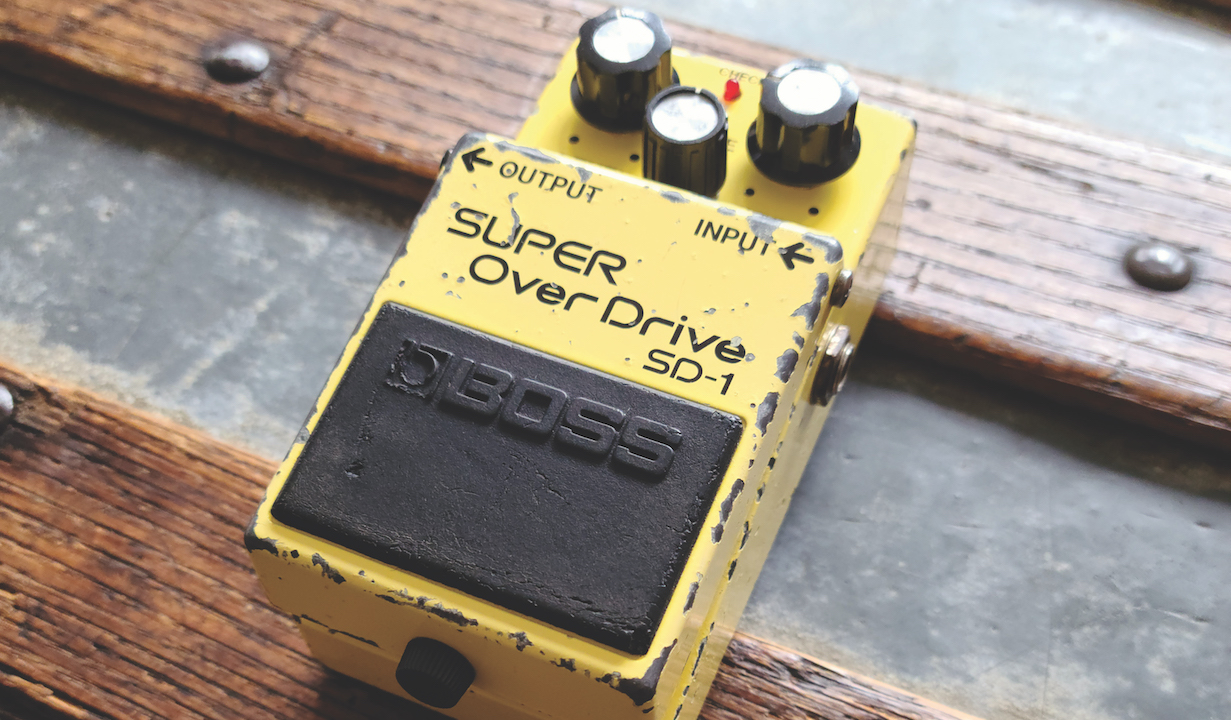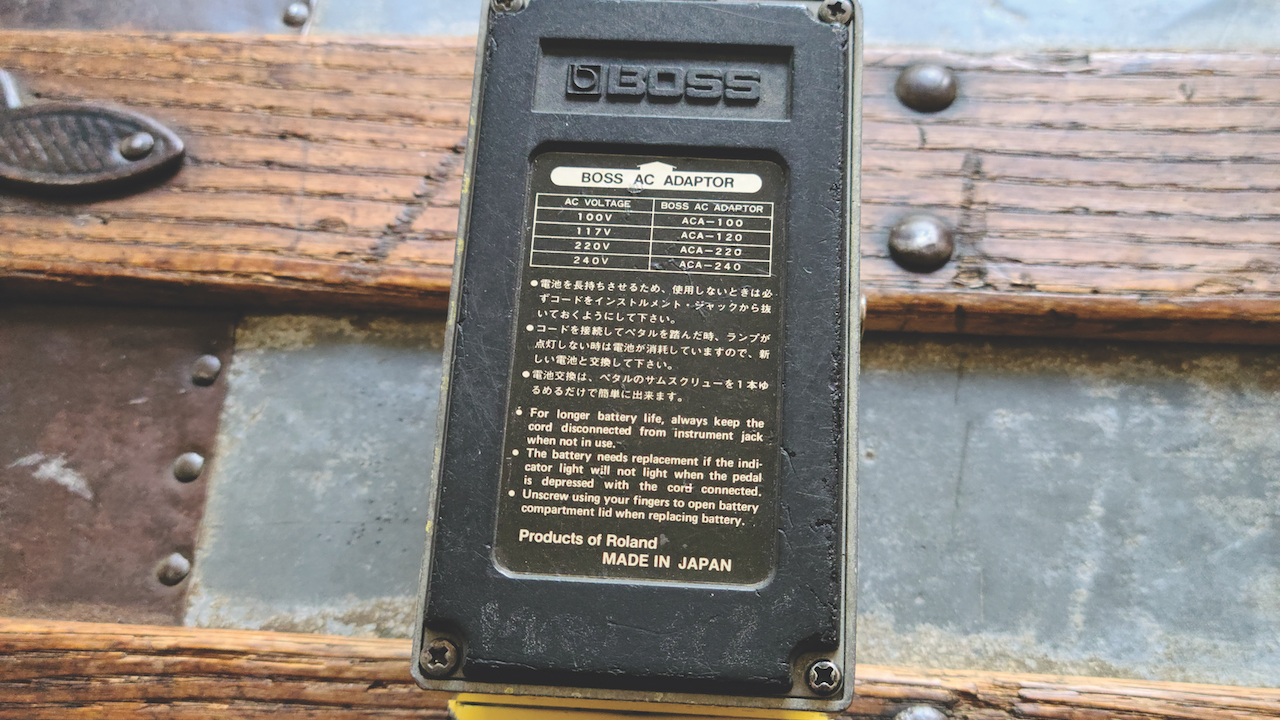For those about to rock: we salute the Boss SD-1 Super OverDrive which has wowed lead guitarists for over 40 years with its jagged, granular tone
Boss brought out the SD-1 Super OverDrive in 1981, refining the circuit for more gain and aggression and adding a tone knob – and it’s sold by the millions

Amid all the exotic, vintage bucket-brigade delays and germanium-transistor fuzzes that qualify as classic pedals, one humble three-knob overdrive has been doing the job for 42 years with little romance or acclaim, and probably juicing the tones of more rigs and recordings than any other single pedal on the planet.
Introduced in 1981, the Boss SD-1 Super OverDrive represented the OD pedal come of age — a just-right circuit for guitarists requiring pushed-amp tone in situations where an amp can’t easily be pushed, or providing just a little poke to take a lead from satisfactory to luscious.
Worth exploring in and of itself, the SD-1 is also worth considering in light of the many boutique and vintage reissue overdrives that cost two, three or even four times the price. For all the countless pedals that have made attaining a natural, tube-like overdriven amp tone their MO (many of which have been based closely or roughly on the SD-1 itself, or on its Ibanez rival, the Tube Screamer), this simple Boss pedal just gets the job done, and in a way that still comes as a breath of fresh air to many 21st century guitarists now discovering its charms for themselves.
Parent company Roland was making inroads in the effects market in the early to mid ’70s before the Boss lineup came along. The first promising sign came with the release of the CE-1 Chorus Ensemble under the Boss brand in 1976. Just a year later, the company hit the scene in a big way with what was arguably the most modern-leaning and thoughtfully designed pedal range on the market at the time.
Forever after known as the “compact pedal series,” these brightly colored units displayed a number of next-gen performance features: a big and unmissable stomp switch that covered two-thirds of the pedal’s top and doubled as a hinged battery door with thumbscrew access, an LED indicator and a quality buffered bypass.
It says a lot that the pedals have never gone out of fashion. With all the esoteric, small-shop, hand-wired pedals on the market today, Boss pedals appear on more professional boards than those of any other single maker out there, and tens of millions have been sold since the range was launched in 1977.
Along with the PH-1 Phaser and SP-1 Spectrum (kind of an enhancer and parametricEQ combined), the OD-1 OverDrive was among the first three pedals in the range, and it is commonly acknowledged as the first-ever overdrive pedal, a notion that might be difficult to grasp amid the glut of such effects today. (The Maxon/Ibanez TS808 Tube Screamer didn’t hit the street until 1979.)
Get The Pick Newsletter
All the latest guitar news, interviews, lessons, reviews, deals and more, direct to your inbox!

This debutante of drive won plenty of fans and proved a revelation for those trying to achieve edge-of-breakup tone into a relatively clean amp, but it also had its limitations.
Taking the concept further, Boss brought out the SD-1 Super OverDrive in 1981, refining the circuit for more gain and aggression and adding a tone knob to the existing two-knob complement of drive and level.
What had been billed as a “soft overdrive” with the SD-1 was now something a little closer to distortion by the standards of 1981, if not today. The original OD-1 was discontinued in 1985 but has since been reissued.
The adjectives smooth, sweet and symmetrical might appear to be inherent positives when guitar tone is discussed, but many players have long been aware that a slight asymmetricality in a tube amp’s response, induced when slightly mismatched output tubes amplify each side of the sound wave a little differently, can enhance character and cutting power.
The SD-1's asymmetrical clipping produces a drive tone that slices through the mix
The SD-1 goes there by design. By using an unequal number of diodes in its positive and negative clipping rails — two in one, one in the other — the SD-1 induces asymmetrical clipping relatively early in the signal chain, producing a slightly jagged, granular drive tone that slices through the mix and really perks up the ear.
Aided by the enhanced harmonic overtones of the circuit and an appealing level of saturation in general, it’s a pedal that’s easy to love. Into a tube amp set clean-ish or just past the edge of overdrive, the SD-1 can evoke an instant rock vibe or provide the perfect solo gain and voicing boost.
Into a heavier amp, such as the Marshall JCM800, which the SD-1 frequently accompanied in the ’80s, it can help to eviscerate the roll and take your tone totally rock.
Players who have leaned on the SD-1 are almost too numerous to mention, but their range — from Zakk Wylde, Steve Vai, Josh Homme and Kirk Hammett to Robert Smith, Mark Knopfler, Prince and The Edge — goes a long way toward declaring its versatility. The SD-1 has remained in production ever since it’s release.

In 2015, the SD-1w Waza Craft version joined the lineup, offering a voicing switch to flip between Standard and Custom, and in 2021 Boss released a 40th Anniversary SD-1 in a black finish.
Meanwhile, original examples from the early ’80s have attained a certain collectability, but they’re plentiful enough that prices are nowhere near those of many other iconic pedals of the era.
Essential ingredients
- All-analog circuit
- Asymmetrical clipping diodes
- Pale-yellow enclosure
- Timeless Boss compact pedal format
For more info on Boss pedals and other items, please visit the official website
Dave Hunter is a writer and consulting editor for Guitar Player magazine. His prolific output as author includes Fender 75 Years, The Guitar Amp Handbook, The British Amp Invasion, Ultimate Star Guitars, Guitar Effects Pedals, The Guitar Pickup Handbook, The Fender Telecaster and several other titles. Hunter is a former editor of The Guitar Magazine (UK), and a contributor to Vintage Guitar, Premier Guitar, The Connoisseur and other publications. A contributing essayist to the United States Library of Congress National Recording Preservation Board’s Permanent Archive, he lives in Kittery, ME, with his wife and their two children and fronts the bands A Different Engine and The Stereo Field.
Guitar Center's Guitar-A-Thon is back, and it includes a colossal $600 off a Gibson Les Paul, $180 off a Fender Strat, and a slew of new exclusive models
"We tried every guitar for weeks, and nothing would fit. And then, one day, we pulled this out." Mike Campbell on his "Red Dog" Telecaster, the guitar behind Tom Petty & the Heartbreakers' "Refugee" and the focus of two new Fender tribute models














